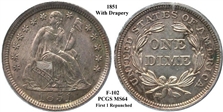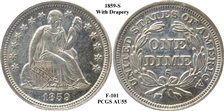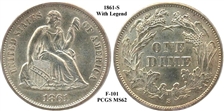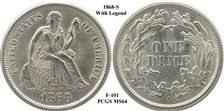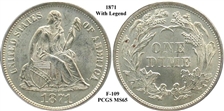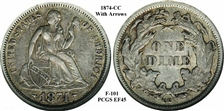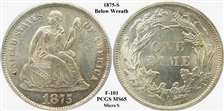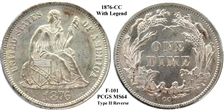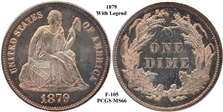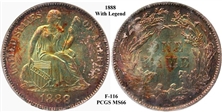Maine Dime Collection 的钱币相册
Mintage: 682,500 (Both date sizes)
Obverse Dies: 3 Known
Fortin Top 100 Seated Dime Varieties #1 - F-101c
The No Stars obverse shows the Christian Gobrecht rendering of the Thomas Sully design, while the reverse has a wreath with ONE DIME, thin long leaves with long stemmed closed berries and the legend UNITED STATES OF AMERICA. All design elements except the date were hubbed into the master die, a technological breakthrough for the time period. First coinage of this group was 30 brilliant proofs struck on June 30, 1837 at the direction of Mint Director, Robert Patterson.
Plate Coin: Fortin-101c, Bold luster highlists finest known example of shattered obverse and clashed dies variety.
Mintage: 682,500 (Both date sizes)
Obverse Dies: 3 Known
Fortin Top 100 Seated Dime Varieties #1 - F-101c
The No Stars obverse shows the Christian Gobrecht rendering of the Thomas Sully design, while the reverse has a wreath with ONE DIME, thin long leaves with long stemmed closed berries and the legend UNITED STATES OF AMERICA. All design elements except the date were hubbed into the master die, a technological breakthrough for the time period. First coinage of this group was 30 brilliant proofs struck on June 30, 1837 at the direction of Mint Director, Robert Patterson.
Plate Coin: Fortin-101c, Bold luster highlists finest known example of shattered obverse and clashed dies variety.
Mintage: 682,500 (Both date sizes)
Obverse Dies: 3 Known
The No Stars obverse shows the Christian Gobrecht rendering of the Thomas Sully design, while the reverse has a wreath with ONE DIME, thin long leaves with long stemmed closed berries and the legend UNITED STATES OF AMERICA. All design elements except the date were hubbed into the master die, a technological breakthrough for the time period. First coinage of this group was 30 brilliant proofs struck on June 30, 1837 at the direction of Mint Director, Robert Patterson.
Plate Coin: Fortin 104, Ahwash 2, Small Date, Heavily Clashed Reverse, Original Rose/Blue Toning On Pristine Surfaces. There are two different Small Date obverse dies with one having a heavier punched date than the other. Fortin 104 is the "lighter" Small Date punch. The "heavier" Small Date obverse is sometimes attributed as a Large Date by the grading services so inspection of 1837 Large Date dimes in grading service holders is recommended.
Mintage: 489,064
Obverse Dies: 1 Known
There are two known die pairings for 1838 New Orleans coinage. Both die pairings employ the same obverse die. The initial 30 specimens of 1838-O dimes were struck on May 7-8, 1838. An additional 367,434 of Ahwash 1 were struck between June and July 1838. The final group (Ahwash 2) was struck in January 1839.
Plate Coin: Fortin 101, Ahwash 1, Repunched O/O, Consistent Medium Golden and Bronze Toning on Obverse and Reverse, Flawless Surfaces, Originally Holdered As ICG65, CoinFacts Plate Coin for 1838-O date.
Mintage: 489,064
Obverse Dies: 1 Known
There are two known die pairings for 1838 New Orleans coinage. Both die pairings employ the same obverse die. The initial 30 specimens of 1838-O dimes were struck on May 7-8, 1838. An additional 367,434 of Ahwash 1 were struck between June and July 1838. The final group (Ahwash 2) was struck in January 1839.
Plate Coin: Fortin 101, Ahwash 1, Repunched O/O, Consistent Medium Golden and Bronze Toning on Obverse and Reverse, Flawless Surfaces, Originally Holdered As ICG65, CoinFacts Plate Coin for 1838-O date.
Mintage: 1,992,500
Obverse Dies: 8 Known
Working dies of 1838 through 1840 were created from the No Stars hub of 1837. Each working die had 13 individual stars hand punched resulting in variations in star placement and size. One obverse in 1838 features smaller stars from a punch intended for half dimes and is known as the Small Stars Obverse. The Stars Obverse type was struck at the Philadelphia during 1838 through 1840 and at the New Orleans mint during 1839 and 1840. For the 1838 Philadelphia date, eight different obverse dies have been identified. Many of the obverse dies are found today with important late die states where the die shows large die cracks that tranverse the obverse.
Plate Coin: Condition Census Gem
Mintage: 1,992,500
Obverse Dies: 8 Known
Working dies of 1838 through 1840 were created from the No Stars hub of 1837. Each working die had 13 individual stars hand punched resulting in variations in star placement and size. One obverse in 1838 features smaller stars from a punch intended for half dimes and is known as the Small Stars Obverse. The Stars Obverse type was struck at the Philadelphia during 1838 through 1840 and at the New Orleans mint during 1839 and 1840. For the 1838 Philadelphia date, eight different obverse dies have been identified. Many of the obverse dies are found today with important late die states where the die shows large die cracks that tranverse the obverse.
Plate Coin: Condition Census Gem
Mintage: 1,992,500
Obverse Dies: 8 Known
Working dies of 1838 through 1840 were created from the No Stars hub of 1837. Each working die had 13 individual stars hand punched resulting in variations in star placement and size. One obverse in 1838 features smaller stars from a punch intended for half dimes and is known as the Small Stars Obverse. The Stars Obverse type was struck at the Philadelphia during 1838 through 1840 and at the New Orleans mint during 1839 and 1840. For the 1838 Philadelphia date, eight different obverse dies have been identified. Many of the obverse dies are found today with important late die states where the die shows large die cracks that tranverse the obverse. The plate coin is the final die state of Obverse 2. This obverse has been paired with three different reverse dies namely, doubled reverse paired with Small Stars Obverse, vertically cracked reverse (Ahwash 3) and the present pairing. During its late die, Obverse 2 exhibits a die crack starting from the rim to the left of the date and progressing through the base and rock and finally ending at LI(B)ERTY. Dealers often refer to this obverse die state as the "unlisted" cracked obverse due to other more significantly cracked obverse dies for this date. The only reverse diagnostic is die roughness between the letters ME in DIME.
Plate Coin: Fortin 104, Even Light Green and Gold Tone, Late Die State But Well Struck
Mintage: 1,992,500
Obverse Dies: 8 Known
Working dies of 1838 through 1840 were created from the No Stars hub of 1837. Each working die had 13 individual stars hand punched resulting in variations in star placement and size. One obverse in 1838 features smaller stars from a punch intended for half dimes and is known as the Small Stars Obverse. The Stars Obverse type was struck at the Philadelphia during 1838 through 1840 and at the New Orleans mint during 1839 and 1840. For the 1838 Philadelphia date, eight different obverse dies have been identified. Many of the obverse dies are found today with important late die states where the die shows large die cracks that tranverse the obverse. The plate coin is the final die state of Obverse 2. This obverse has been paired with three different reverse dies namely, doubled reverse paired with Small Stars Obverse, vertically cracked reverse (Ahwash 3) and the present pairing. During its late die, Obverse 2 exhibits a die crack starting from the rim to the left of the date and progressing through the base and rock and finally ending at LI(B)ERTY. Dealers often refer to this obverse die state as the "unlisted" cracked obverse due to other more significantly cracked obverse dies for this date. The only reverse diagnostic is die roughness between the letters ME in DIME.
Plate Coin: Fortin 104, Even Light Green and Gold Tone, Late Die State But Well Struck
Mintage: Unknown
A single 1838 obverse die was clashed during its life resulting in the transfer of reverse wreath details to the area below Libertys right arm. This die clash was first attributed as partial drapery and the designation has remained popular with date and variety collectors.
Plate Coin: Fortin-108a, A Near-Gem That Boasts Copper-Gray and Light Green Patina.
Mintage: 1,053,115
Obverse Dies: 5 Known
The plate coin is the earliest die state seen for Obverse 1. The 3 and 9 digits in the date show repunching. The 3 digit shows repunching below the lower loop while the 9 digit shows repunching within the upper and lower loops. Stars 5 and 6 are repunched while Star 11 shows repunching outside its star point facing Liberty. Obverse 1 is paired with Reverse A, which shows considerable wear around UNITED and AMERICA. There is a faint die crack from the wreath to AME(R)ICA. Evidence of die erosion can also be seen behind O(NE). Reverse A is rotated left 18 degrees.
Plate Coin: Fortin-101, Repunched 39 Digits, Fully Struck Gem with Original Blue, Gold and Rose Toning Throughout
Mintage: 1,053,115
Obverse Dies: 5 Known
The plate coin is the earliest die state seen for Obverse 1. The 3 and 9 digits in the date show repunching. The 3 digit shows repunching below the lower loop while the 9 digit shows repunching within the upper and lower loops. Stars 5 and 6 are repunched while Star 11 shows repunching outside its star point facing Liberty. Obverse 1 is paired with Reverse A, which shows considerable wear around UNITED and AMERICA. There is a faint die crack from the wreath to AME(R)ICA. Evidence of die erosion can also be seen behind O(NE). Reverse A is rotated left 18 degrees.
Plate Coin: Fortin-101, Repunched 39 Digits, Fully Struck Gem with Original Blue, Gold and Rose Toning Throughout
Mintage: 1,323,000
Obverse Dies: 5 Known
A total of five different obverse dies and six reverse dies have been identified for 1839 New Orleans coinage. 1839-O dimes with a Small O mintmark are extremely rare in mint state. The plate coin was puchased at the Heritage pre ANA auction for an amount well above price guide values and is most likely the finest Small O 1839-O dime extant.
Plate Coin: Fortin 101, Small O, The Strike is Needle-Sharp, Every Aspect of Libertys Head, Stars, and all the Obverse Devices are Crisp and Pronounced. On the Reverse, Every Leaf, Letter, and Berry is Bold. Both Obverse and Reverse are Toned a Sunset-Gold at the Periphery, Lighter at the Centers.
Mintage: 1,323,000
Obverse Dies: 5 Known
A total of five different obverse dies and six reverse dies have been identified for 1839 New Orleans coinage. 1839-O dimes with a Small O mintmark are extremely rare in mint state. The plate coin was puchased at the Heritage pre ANA auction for an amount well above price guide values and is most likely the finest Small O 1839-O dime extant.
Plate Coin: Fortin 101, Small O, The Strike is Needle-Sharp, Every Aspect of Libertys Head, Stars, and all the Obverse Devices are Crisp and Pronounced. On the Reverse, Every Leaf, Letter, and Berry is Bold. Both Obverse and Reverse are Toned a Sunset-Gold at the Periphery, Lighter at the Centers.
Mintage: 981,500
Obverse Dies: 8 Known
Eight different obverse dies are known for 1840 No Drapery coinage, including the Chin Whisker variety. Specialist know that Obverse 7 is atypical from other 1840 No Drapery dies due to weaker device and date details. Was Obverse 7 lapped more aggressively than other working dies before employed for coinage production? Reverse G also shows considerable weakness within the devices and could support the explanation of lapping prior to usage.
Plate Coin: Fortin 107, Obverse 7, Previously NGC MS66, Superior Luster with Peripheral Ranges of Rose/Blue Toning, the Reverse Being More Accentuated
Mintage: 1,175,500
Obverse Dies: 7 Known
Obverse 4 is one of 7 different 1840 New Orleans obverse dies. This obverse comes fairly well struck but is already showing signs of die erosion around the stars. Use the repunching on Stars 9 through 11 to identify this obverse die. The reverse is also well struck with a nicely centered Small O mintmark. To date, 5 Small O reverse dies have been identified. This reverse die has begun to show die erosion. Die cracks from the rim to ERIC in AMERICA are evident.
Plate Coin: Fortin-103, Ex. Lovejoy, Small O of 1839, Even Light Gold Toning, Very Rare Mintmark Variety
Mintage: 377,500
Obverse Dies: 1 Known
A modified Hughes effigy of Liberty occurred in late 1840 and is presently known as the With Drapery and Stars design group. This new portrait presents Liberty with an upright shield and broader body covered by flowing drapery. Additional fabric was added beneath Liberty's exposed right arm. The addition of the bulla to weigh down the drapery presents an important sighting point for variety attribution. Reverse modifications, though subtle, include larger denomination letters and open buds in the wreath.
Plate Coin: Fortin-101, Single Die Pair, Nice Luster Over Essentially Untoned Surfaces, A Duplicate to an NGC62 1840 WD Dime, Rare This Nice and in Grades of AU or Better
Mintage: 1,622,500
Obverse Dies: 8 Known
A total of eight different obverse dies have been identified for 1841 Philadelphia coinage.
The plate coin is an Obverse 3, repunched 184 example which is paired with a second reverse die that is rotated 18 degrees right. Reverse D is perfect during this early die state. I have found rust free reverse die examples to be difficult to locate. Most later die state examples exhibit progressive levels of damage as Reverse D is rusting. The ME in DIME and the UN in UNITED are the prime areas of inspection for determining the level of damage to Reverse D.
Plate Coin: Fortin 104, Repunched 184, Wonderful Rose, Green, Blue and Golden Toning
Mintage: 2,007,500
Obverse Dies: 10 Known
For 1841 New Orleans coinage, a total of ten different obverse dies and twelve reverses dies have been identified with multiple die pairings. The most significant varieties for 1841 New Orleans coinage are the Large O and Small O transitional Closed Bud reverses. Both Closed Bud reverse dies were left over reverse dies from 1840 and were paired with the same 1841 obverse die for production in early 1841 before additional reverse dies arrived from the mother mint in Philadelphia.
Plate Coin: Fortin 115, Small O, Well Struck With Light to Medium Rose, Gold and Orange Toning Throughout, Very Original
Mintage: 1,887,500
Obverse Dies: 7 Known
Seven different obverse dies have been identified for 1842 Philadelphia coinage, including the proof die. Segragating 1842 obverse dies is difficult due to minor differences in date position placement.
The 1842 plate coin variety (Ahwash 3) is always seen with a bold rim cud from Star 3 to Star 5. The date digits are heavily punched with the 84 digits touching. A faint die crack joins Stars 7 and 8 with Liberty's head. The reverse die features an abundance of die lines between the right rim and wreath. A large series of parallel die lines originate from the right rim into the letters ERICA of AMERICA. Another significant die line passes through the first S of STATES.
Plate Coin: Fortin 103a, Ahwash 3, Rim Cud at 10:00, Even White and Lustrous Example, Finding an Acceptable Upgrade has been Quite Difficult
Mintage: 2,020,000
Obverse Dies: 4 Known
Four obverse dies and potentially five reverse dies have been identified for 1842 New Orleans coinage. The key diagnostic point for Obverse 4 is the die gouge to the left of Liberty's index finger. Tim Cook pointed out the possibility of using this die gouge as an attribution point around 1998. The date placement on Obverse 4 is very similar to Obverse 3, so the die gouge marker is very useful and recommended given the additional die states of this obverse die. Obverse 4 also exhibits a large die blob defect in the right field between Liberty's knee and Star 12. Reverse E features a Medium O mintmark that is positioned right and high. Faint die cracks are just beginning to emerge on the plate coin. I have seen another earlier die state example with no reverse cracks. Both the obverse and reverse are well struck during this die state, unfortunately this does not last long as the dies are polished and subsequently degrade.
Plate Coin: Fortin 105, Medium O, Even Silver Gray Obverse With Light Rose Reverse Toning, Second Finest Graded at PCGS, Well Struck for 1842 O Mint
Mintage: 1,370,000
Obverse Dies: 4 Known
Obverse 4, one of four obverse dies identified to date, exhibits several key diagnostics. The 3 digit in the date is repunched north, look under the top crossbar for this evidence. Obvious die scratches are also seen from Liberty's foot to the rim, with others between Stars 12, 13 and rim. Ahwash listed this obverse as both A-3 and A-5, however I am convinced that the same die is responsible for his two separate observations. Reverse E exhibits noticeable die scratches from the rim to U(NIT)ED.
Plate Coin: Fortin 105, Awhash Plate Coin, Ahwash 5, Repunched 3, Untoned and Well Struck
Mintage: 150,000
Obverse Dies: 1 Known
A single die pair was employed for 1843 New Orleans coinage. A very scarce date to obtain in problem free VF or better grade with well struck and original 1843-O examples in EF or better proving to be rare. The 1843-O is a key date in AU or better and is extremely rare in Mint State grade.
The reverse die will show progressive die cracks at the 2nd T in STATES and the M in AMERICA to rim. Die rust is evident within the central portion of the wreath leaves and around the bow knot. 1843-O dimes have a Medium O mintmark which is positioned left and high.
Plate Coin: Fortin 101, Strictly Original Surfaces, Gun Metal Toning, Condition Rarity and Grade For 1843 New Orleans Dime
Mintage: 72,500
Obverse Dies: 2 Known
A historically scarce date but rare during the past 15 years is a result of excessive hoarding. The recent dispersion of the CA hoard has increased availability in grades up through EF45. 1844 dimes are scarce in grades of AU or better with few Mint State examples known. This date, nicknamed the "Little Orphan Annie" dime, has been a favorite target of hoarders throughout its existence.
A single die pair was employed for business strikes while a second die pair was used for proof coinage. On the business strike obverse, die lines are seen on both the lower left and right sides of the reverse. The most significant are located between the rim and UNITED on the left side of the reverse die with additional die lines between rim and the letters ERIC in AMERICA.
Plate Coin: Fortin 102, Even light gray toning over original and problem free surfaces; residual luster is evident throughout. Though graded AU58, this dime is in the condition census for the date.
Mintage: 230,000
Obverse Dies: 1 Known
1845-O dimes are extremely rare in Mint State, with the Eliasberg 1845-O dime being the finest known. Several well struck AU coins have been offered at conventions and Internet auctions in the past several years. The current CoinValues pricing in AU50 through MS63 grades remains understated.
Plate Coin: Fortin 101, Pittman Pedigree, Well Struck Example in a Condition Census Grade, Beautiful Rose, Green and Blue Toning
Mintage: 31,300
Obverse Dies: 2 Known
Only one obverse die (Obverse 1) was used for business strikes while a second obverse is seen on proof coinage. On business strikes, the 6 digit in the date has a defect between the upper loop's ball and the upper section of the lower loop. The space between the crossbar of the 4 digit and the bottom feet is partially filled. Liberty's fingers, on the right hand grasping the pole, are poorly defined. The die area between the toe and adjacent denticle appears to be defective. Die chips are found around all stars with Stars 3, 4, 5, 6 and 13 exhibiting the boldest die chips. The date on business strikes is level while on proofs (Obverse 2), the date slopes downward. Ahwash indicates that Reverse A has repunching in the legend with die cracks from the rim to the tops of (A)ME(R)I(CA). A close inspection of the plate coin revealed the presence of die lines from the tops of (A)ME(R)ICA to the rim.
Plate Coin: Fortin 101, Condition Census Example, Proof Like Surfaces and Well Struck, A Choice Example of the Elusive 1846 Date In High Grade
Mintage: 245,000
Obverse Dies: 3 Known
High grade 1847 examples are typically well struck with nearly full heads. The three 1847 varieties are popular due to their inclusion in the Ahwash encyclopedia.
Plate Coin: Fortin 102, Ahwash 2, All Digits Touch Base, Light Gray and Brown Obverse Toning, Increased Rose Toning On Reverse, Very Well Struck
Mintage: 839,000
Obverse Dies: 5 Known
Four obverse and reverse dies have been identified for 1849 business strike coinage while a separate obverse die is known for proof coinage.
In Mint State, this date is very scarce and will prove to be difficult to locate.
Plate Coin: Fortin 105, Ahwash 4, A Well Struck White Coin With Lustrous Surfaces
Mintage: 300,000
Obverse Dies: 3 Known
In problem free EF or better, 1849-O dimes are difficult to locate. Mint State specimens are available but at a significant premium to later New Orleans Mint State dimes from 1850 through 1852. Large O examples are nearly always weakly struck on obverse and reverse. Finding a fully struck Large O dime will be very challenging and could take many years. Small O Varieties 102 and 104 are the most likely to be found well struck. Three obverse dies and two reverse dies were used to produce the 1849 New Orleans coinage.
Plate Coin: Fortin 101b, Large O Reverse With Die Cracks, Incredible Toning Throughout and a Bold Strike for Large O Coinage, Simply One of the Finest 1849-O Examples Seen
Mintage: 1,931,500
Obverse Dies: 8 Known
For the 1850 Philapelphia date, eight obverse and nine reverse dies have been identified. Obverse 2, on the registry coin, is easy to attribute through its very high date and the 185 digits touching the base. Reverse C has heavy die flash around bow loops and knot.
Plate Coin: Fortin 103, Pittman Collection, Ahwash 3, Golden and Blue Toning Over Prooflike Surfaces, A Fine PQ Example
Mintage: 1,026,500
Obverse Dies: 6 Known
A total of six obverse and seven reverse dies have been cataloged for 1851 Philadelphia coinage. This is a difficult date to research for varieties due to limited movement in the date placement. Most examples are well struck and do not show significant die cracks. Three different repunched obverse dies are known.
Plate Coin: Fortin 102, Repunched First 1 Digit, Outstanding Silver Gray with Iridescent Toning Accents on the Obverse and Reverse. Sharply Struck with Full Stars, Strong Head Details, and Bold Branches.
Mintage: 1,100,000
Obverse Dies: 4 Known
The 1853 New Orleans date is rarely found with full head detail and a strong strike. Of the four known obverse dies, dimes from Obverse 2 typically show full heads and strong dates even though this die does shatter with usage. Dimes from Obverse 1 are almost always seen with little or no head detail and haloing around the left stars. Obverses 3 and 4 exhibit weak dates.
The date and arrows placement on 1853 New Orleans dimes is consistent across all obverse dies as seen with the hubbed subset of 1853 With Arrows Philadelphia dies. At this point in time, it can be concluded that the date and arrows were placed into the hub die for New Orleans obverse dies. Interestingly, both reverse dies from 1852 are again used by the New Orleans mint to strike 1853 coinage.
Plate Coin: Fortin 103, Eliasberg Pedigree in OGH. Both Obverse and Reverse are Fully Struck for F-103 Variety Which is Extremely Difficult to Locate. Original Rose/Gold Toning Over Lustrous Surfaces. Many Years of Searching for a Fully Struck Mint State 1853-O Dime has Come to an End.
Mintage: 4,470,000
Obverse Dies: 11 Known
Both the date and arrows were placed on the master hub for 1854 dimes resulting in a consistent positioning of these devices on the obverse die. Variations in date hubbing strength on the working dies produced strong and weak date transfers.
Plate Coin: Lightly Gold Toned Gem Example
Mintage: 1,770,000
Obverse Dies: 10 Known
As with 1854 Philadelphia, on 1854 New Orleans coinage the date and arrows were placed on the master hub dimes resulting in a consistent placement of these devices on the obverse die. Variations in the strength of the date hubbing of the working dies produced strong and weak dates.
Plate Coin: Fortin 105, Die Crack Through 8 Digit In The Date, Very Well Struck With Even Luster Throughout, Light Gold/Brown Toning On Reverse
Mintage: 2,075,000
Obverse Dies; 8 Known
Both the date and arrows were placed on the master hub for 1855 dimes resulting in a consistent positioning of these devices on the obverse die. Variations in date hubbing strength on the working dies produced strong and weak date transfers. The working die preparation process produced at least three 1855 obverse dies with doubling in the date or shield. 1855 dimes are much more difficult to find sharply struck than their 1853 or 1854 With Arrows counterparts.
Plate Coin: Fortin 101a, Obverse Die Used For Proof Strikes, Satiny Luster on Both the Obverse and Reverse of This Near-Gem. The Strike is Sharp and the Surfaces are Problem Free. Lightly Patinated in Golden-Gray Hues
Mintage: 5,780,000 (Including Large Dates)
Large Date Obverse Dies: 4 Known
During 1856, both Large Date and Small Date dimes were struck. Large Date dimes are rare in Mint State and the recent upward adjustment in Coin World Values pricing is more reflective of their scarcity. Small Date examples are much more common than Large Dates in both circulated and Mint State grades.
Four 1856 Large Date obverse dies and twenty two Small Date obverse dies have been identified to date.
Plate Coin: F-104, Very High Large Date, Low Mint State Population, Light Mottled Rose and Gray Toning Throughout Over Problem Free Surfaces
Mintage: 1,180,000
Obverse Dies: 6 Known
A better date in the Seated Dime series and challenging to locate in grades of EF or higher. The Large O has historically been more available than the Medium O, which is rare in EF or better. However a significant number of Medium O dimes have surfaced recently.
Six different obverse and reverse dies have been identified for 1856 New Orleans coinage.
Plate Coin: Fortin 101, Large O, Difficult Variety in Mint State, Incredible Original Toning, Satiny Luster, Predominantly Blue, Green Obverse Tone, Reddish Orange on the Reverse
Mintage: 5,580,000
Obverse Dies: 16 Known
A common date in all grades, sixteen separate obverse dies being documented, though more obverse dies will be identified in the future.
Plate Coin: Fortin 116, A Well Struck and Lustrous Antebellum Gem that Exhibits Russet and Tan Patina at the Periphery.
Mintage: 1,540,000
Obverse Dies: 5 Known
1857 New Orleans coinage is found with Large and Medium reverses. The Medium O is moderately scarcer than the Large O in circulated grades and is very scarce in Mint State. The Large O is more available in Mint State.
Five obverse dies and six reverse dies have been identified for 1857 New Orleans coinage.
Plate Coin: Fortin 101a, A Sharp and Gorgeous Gem with Rich Underlying Lustre Supporting a Wealth of Peach, Gold, and Pale Rose Iridescence Tone.
Mintage: 1,540,000
Obverse Dies: 10 Known
Variety collectors will be limited to date position variations for 1858 dimes. Most dates slope downward, making the task of obverse die attribution difficult. 1858 dimes with die cracks are scarce since the limited mintage of 1,540,000 pieces appears to have been evenly produced across the nine business strike obverse dies.
Plate Coin: Fortin 110, An Incredible Dime With Superior Eye Appeal Beyond Its MS63 Assigned Grade
Mintage: 60,000
Obverse Dies: 1 Known
The second rarest San Francisco mint Seated dime above VF grade after the 1858-S date. Extremely rare in Mint State with few certified by the top grading services. A single die pair is known for the 1859 San Francisco coinage.
In the past three years, several certified AU examples have appeared at auction bringing strong monies well above Coin World's CoinValues. A lone example is known in PCGS MS65 grade and sold in excess of $50,000 at auction.
Plate Coin: Fortin 101, White and Lustrous With Faint Gray Toning Near the Rims, Bold Strike With No Signs of Reverse Roughness as is Typical for This Date
Mintage: 40,000
Obverse Dies: 1 Known
The 1860 New Orleans date is scarce in the lower circulated grades and often comes porous due to examples being dug out of
the ground. Rare in problem free EF-AU and becomes extremely rare in Mint State. One of the key dates to the Liberty Seated Dime series.
Plate Coin: Fortin 101, Original brown and golden toning throughout with mark free field. Light wear and fully deserving of AU50 designation. A specimen that will not be upgraded in my lifetime.
Mintage: 40,000
Obverse Dies: 1 Known
The 1860 New Orleans date is scarce in the lower circulated grades and often comes porous due to examples being dug out of
the ground. Rare in problem free EF-AU and becomes extremely rare in Mint State. One of the key dates to the Liberty Seated Dime series.
Plate Coin: Fortin 101, Original brown and golden toning throughout with mark free field. Light wear and fully deserving of AU50 designation. A specimen that will not be upgraded in my lifetime.
Mintage: 172,500
Obverse Dies: 2 Known
The 1861 dimes from San Francisco were struck from two Type I obverse dies and a single reverse die. This date is scarce in circulated grades and become very scarce in VF or better. Very rare in Mint State. This is the toughest San Francisco branch mint date in the 1860's to locate.
Plate Coin: Fortin 101, Condition Census Example With Lustrous, Satiny Surfaces, Well Struck With Hints of Delicate Golden-Russet Toning at the Base of the Reverse
Mintage: 847,550
Obverse Dies: 8 Known
Nearly all 1862 dimes come well struck. Many examples are found with prooflike surfaces. To date, eight different obverse dies have been identified for Philadelphia coinage.
Plate Coin: Fortin 102a, Business Strike From Proof Dies, Strictly Original As Expected With MS66 Grade, Medium Gray/Rose/Lavender Toning Over Soft Luster
Mintage: 180,750
Obverse Dies: 1 Known
1862 San Francisco dimes are very similar in scarcity to 1861 San Francisco examples and are considered very rare (R7+) in Mint State.
Infrequently, 1862-S dime can be found with a rotated reverse. Three examples have surfaced over the past ten years or so.
Plate Coin: Fortin 101, Even Gold Toning With Peripheral Deeper Gray, Strictly Original With Bold Strike, Formerly in the Richmond, Waldo Bolen and Norweb Collections
Mintage: 14,460
Obverse Dies: 1 Known
A difficult and rare date for business strike. Proof examples are more available than business strikes. A single pair of Philadelphia dies were used to strike both the proof and business strike coinage.
Plate Coin: Fortin F-101a, Peripheral Toning in Mottled Cobalt-Blue Shades, Well Struck Obverse. Single Die Pair for Year.
Mintage: 157,500
Obverse Dies: 1 Known
Strike weakness is common for 1863 San Francisco coinage. Examples are often seen with a flat head and weakness in the letters (OF AME)RICA. Reverse weakness will be found on the bow knot and lower wreath. Only one die pair is known.
Scarce in all circulated grades and becomes difficult in problem free EF-AU. Another San Francisco mint date that is rare in Mint State.
Plate Coin: Fortin 101, A Silky, Satiny Specimen With Intense Cartwheel Luster. Faint Sky Blue, Gold and Rose Toning, Well Struck Throughout. Formerly in the Frog Run, Lovejoy and Reed Hawn Collections
Mintage: 11,470
Obverse Dies: 2 Known
1864 Philadelphia dimes are found well struck and will exhibit surfaces that are typically prooflike or semi prooflike.
Two obverse and reverse dies are known for the 1864 date. Ahwash believed that both busines and proofs were struck from each set of dies. However I have only been able to locate business strikes from one of the die pairs.
Plate Coin: Fortin 102a, Gem Example of Ahwash 2, Fully Struck With Surfaces That Are Exceptionally Clean. Satin-Like Mint Luster and Lightly Die Clashed as Many of This Variety Are.
Mintage: 10,500
Obverse Dies: 2 Known
Two sets of dies were used to strike 1865 Philadelphia coinage. This date comes well struck when it can be located. Business strikes are currently in strong demand and are difficult to locate.
The two 1865 die pairs will be found in progressive die states and have produced interesting varieties. The first pair (Obverse 1/Reverse A) was thought to have been used for both proof and business strike coinage by Ahwash, however I have only seen business strikes from these dies. The die pair becomes heavily clashed during its end of life for business strikes. The second die pair (Obverse 2/Reverse B) was though to have also produced both proofs and business strikes by Ahwash. However, I have only seen proofs from this die pair, with a spectacular 180 degree rotated reverse variety being known for the die pair.
Plate Coin: Fortin 101a, Repunched Date, Condition Census, Wonderful Luster and Cameo Effect
Mintage: 175,000
Obverse Dies: 3 Known
For 1865 San Francisco coinage, three obverse and reverse dies were used, one of the reverse dies being "left over" from 1861. These die produced five different obverse/reverse pairings.
In general, 1865-S dimes are typically seen with flat heads and a weak mintmark. This observation can be explained by the higher availability of Variety 101. Locating an example of Variety 101 with a full head could take years.
Finding AU or better 1865-S dimes in choice original condition could take years of searching. Most examples seen have been cleaned, though the grading services still certify some examples in this state of preservation.
Plate Coin: Fortin 101, White and Well Struck, Extremely Rare Full Head Example in a Condition Census Grade, Formerly Eliasberg Collection
Mintage: 135,000
Obverse Dies: 2 Known
Two obverse and reverse dies used in 1866 by the San Francisco mint to produce three die pairing varieties.
The two reverse dies can be easily distinguished by the appearance of the mintmark. There is a weak mintmark reverse (Small Weak S) and a bold mintmark reverse (Small Thin S). Most 1866 San Francisco dimes will come from the reverse with a weak mintmark as Varieties 101 and 103 are more common than 102.
Plate Coin: Fortin 101, Downward Sloping Date, Weak Mintmark, Light Mottled Rose and Gold Toning Throughout, Finest Certified By PCGS
Mintage: 140,000
Obverse Dies: 2 Known
Two obverse dies and one reverse die are known for 1867 San Francisco coinage. All 1867 San Francisco dime come with a strong mintmark, even in the lower circulated grades. Variety 101 is typically found with weakness at Liberty's head and on the bow knot. Well struck examples of Variety 102 can be located.
Plate Coin: Fortin 102, Ahwash 2, Fully Struck With Wonderful Subtle Luster and Light Gold Toning, A Strictly Original Example
Mintage: 464,600
Obverse Dies: 12 Known
The 1868 Philadelphia date has been full of surprises. The twelve known obverse dies are extremely high given a moderate mintage of 464,600 pieces. It could be speculated that the Philadelphia mint planned to significantly increase Seated dime production in 1868 after the low mintage years of 1863 through 1867. Many die pairs were produced but saw limited usage as evidenced by the striking quality of 1868 dimes and the complete lack of late die state or cracked dies.
Plate Coin: Fortin 112, Wonderful Gem Example, Hints of Obverse Toning, Reverse Untoned
Mintage: 260,000
Obverse Dies: 1 Known
A single die pair was used for 1868 San Francisco coinage. This date is scarce in the lower circulated grade and becomes very scarce in EF-AU, rare in Mint State and presently underrated in CoinValues.
For years a separate doubled reverse die was listed by Breen and Greer. In 2005, research revealed that the doubled reverse die was caused by strike doubling and not die doubling via a shifted second hubbing of the reverse die.
Plate Coin: Fortin 101, Fully Struck and Lustrous, High End PQ Is Best Way To Describe This Rare Date In Mint State. Purchased in an ICG MS65 Holder.
Mintage: 450,000
Obverse Dies: 2 Known
Two sets of dies were used for 1869 San Francisco coinage. The reverse dies can be identified by a Small Thin S and and a Small Weak S mintmark. The Small Thin S is much more common than the Small Weak S.
Plate Coin: Fortin 102, Bold Strike and Luster With Faint Traces Of Gold Patina, Weak S Mintmark, Reverse of 1870-S and 1871-S
Mintage: 50,000
Obverse Dies: 1 Known
The 1870 San Francisco date is very scarce in all grades and becomes rare in EF or better. In Mint State, the release of a small hoard allows some availability, though the date is still considered rare.
Plate Coin: Fortin 101, Well Struck, Bold Luster with Light Golden Toning
Mintage: 907,710
Obverse Dies: 13 Known
To date, thirteen obverse dies have been documented for 1871 Philadelphia coinage. A relatively common date in lower grades that becomes scarce in EF or better. This date is very scarce in Mint State and has proven to be elusive during the past few years.
Plate Coin: Fortin 109, Well Struck, White and Lustrous
Mintage: 20,100
Obverse Dies: 1 Known
All Carson City dimes from 1871 through 1874 are found with wider reeding than coinage from the Philadelphia or San Francisco mints. Additionally, only one reverse die was used to strike the Carson City mintage for those four years. Both of these characteristics can be used as a diagnostic to verify genuine Carson City dimes from 1871 through 1874. Carson City dimes are typically found with surface porosity as many have been recovered from the ground. Larry Briggs also notes in his Comprehensive Encyclopedia of United States Liberty Seated Quarters that "The Carson City mint was known to shortcut their annealing process and instead of using 90% silver, 10% copper mixture, used pure Comstock silver."
Without copper in the alloy to harden the silver, Carson City dimes would be highly susceptible to environmental factors.
Plate Coin: Fortin 101, Original Gunmetal Gray Toning with Problem Free Surfaces For An 1871 Carson City Dime, One of the Highlights of the Fortin PCGS Registry Set
Mintage: 320,000
Obverse Dies: 2 Known
Two sets of obverse and reverse dies for 1871 San Francisco coinage producing three separate die pairing varieties. A scarce date that is more difficult to locate than its mintage would suggest. Rare and underrated in Mint State.
Plate Coin: Fortin 101, Repunched 18, Well Struck For 1871-S, Silver Centers with Radial Brown Toning
Mintage: 35,480
Obverse Dies: 1 Known
In the lower circulated grades, the 1872 Carson City dime is more available than its 1871, 1873 With Arrows and 1874 counterparts. However in grades of EF or better, the 1872 Carson City dime becomes extremely rare. This date is excessively rare in Mint State.
Plate Coin: Fortin 101, Conditionally Rare, Moderate Layer Of Original Gray Toning on Both Obverse and Reverse
Mintage: 190,000
Obverse Dies: 1 Known
A single die pair was employed for 1872 San Francisco coinge. This is a difficult date to locate in all circulated grades and consistent in scarcity with the 1871 San Francisco date. 1872 San Francisco Seated dimes are rare in Mint State condition as demonstrated by the low NGC and PCGS populations.
Plate Coin: Fortin 101, Hints of Lilac and Gold Patina Over Problem Free Surfaces, Bold Strike, Obverse Die Cracks
Mintage: 1,508,000 (Closed 3) and 60,000 (Open 3)
Obverse Dies: 8 Known (Closed 3) and 3 Known (Open 3)
1873 Philadelphia dimes without arrows are found with an Open 3 and Closed 3 digit. For years the Open 3 variety has been afforded a premium over the Closed 3 variety due to the low reported Open 3 mintage. In circulated grades, I would question if the premium is warranted and secondly, question if the reported Open 3 mintage of 60,000 was properly recorded or estimated. In Mint State, Open 3 dimes are much rarer than their Closed 3 counterparts.
Plate Coin: Closed 3, Fortin 105, Very Sharp Strike
Mintage: 2,378,500
Obverse Dies: 23 Known
A common date in all grades except Mint State. 1873 With Arrows Mint State examples are more difficult to locate than their 1874 With Arrows counterpart. To date, twenty-three obverse dies have been identified after years of diligent searching.
Plate Coin: Fortin 104, Repunched 1, Traces of Repunching Are Visible Above the Left and Right Bases of the 1 Digit. Soft Light Gray Tone Throughout, Well Struck
Mintage: 18,791
Obverse Dies: 1 Known
Genuine 1873 With Arrows Carson City dimes will always come with wide reeding and a die crack through the mintmark. This die crack should be visible on all circulated grade examples.
In circulated grades from G through VF, the 1873 With Arrows Carson City date is very scarce and becomes rare in EF. In Mint State, this date is excessively rare with few examples known to exist.
Plate Coin: Fortin 101, Medium Gray and Brown Toning, Problem Free and Quality Surfaces For 1873 Carson City Dime
Mintage: 455,000
Obverse Dies: 2 Known
Two obverse and reverse die pairs were employed for 1873 With Arrows San Francisco coinage. The reverse dies have been labeled as Small Block S and Small Thin S due to their mintmark shapes.
Mint State examples are available with the Small Block S variety being slightly more difficult than the Small Thin S.
Plate Coin: Fortin 101, Repunched 1, Ahwash 1, Small Thin S Mintmark, Well Struck Example With Light Gold/Gray Toning
Mintage: 2,940,000
Obverse Dies: 13 Known
The 1874 With Arrows Philadelphia date is common in all grades. More available in AU Mint State grades than the 1873 With Arrows date. To date, thirteen different obverse dies have been identified.
Plate Coin: Fortin 103, Repunched 74, White With Hint Of Light Gray Toning
Mintage: 10,817
Obverse Dies: 1 Known
The key date to the Liberty Seated Dime series. 1874 Carson City dimes are rare in all grades and are almost always encountered with surface problems. Extremely rare in Mint State.
Always under strong collector demand with problem free examples bringing in excess of trend sheet prices. During 2003 and 2004, there was a rapid escalation of pricing for problem free 1874 Carson City dimes. During 2005, it appears that those pricing gains had stabilized but auction results in 2006 have shown another round of pricing increases.
Plate Coin: Fortin 101, Problem Free Surfaces With Old Light Brown/Gray Toning, Well Struck for 1874 Carson City Issue
Mintage: 240,000
Obverse Dies: 2 Known
Two sets of obverse and reverse dies were employed for 1874 San Francisco coinage. The reverse dies are identified as Small Thin S and Micro S due to the mintmark shape and sizes.
The strike quality of the 1874 San Francisco dimes is much poorer than Philadelphia examples. Both the Small Thin S and Micro S varieties (when it can be located) are often seen with uneven strikes and weakness in Liberty's head. Strike weakness can be acute on Small Thin S reverses.
Plate Coin: Fortin 101, Micro S, A Gem Example with Even Bronze Toning Highlighting a Full Struck Throughout, CAC Certified
Mintage: 10,350,700
Obverse Dies: 21 Known
1875 Philadelphia dimes are common in all grades including Mint State. It is expected that additional date position varieties will continue to surface as I have not made a priority of researching 1875 die varieties.
Plate Coin: F-124, Well struck gem example with golden obverse and reverse centers that transition to peripheral rose, blues and green tones.
Mintage: 4,645,000 (both In and Below Wreath Varieties)
Obverse Dies: 10 In Wreath and 7 Below Wreath Known
1875 Carson City dimes will be found with the CC mintmark "In the Wreath" and "Below the Wreath". A common date and variety in all grades. The In Wreath variety is much more available than the Below Wreath variety though the Below Wreath is still fairly common in the lower circulated grades.
Plate Coin: Fortin 106, CC Mintmark In Wreath, Light Blue and Rose Toning Over Magnificent Surfaces, Wonderful Gem in Second Generation PCGS Holder
Mintage: 4,645,000 (both In and Below Wreath Varieties)
Obverse Dies: 10 In Wreath and 7 Below Wreath Known
1875 Carson City dimes will be found with the CC mintmark "In the Wreath" and "Below the Wreath". A common date and variety in all grades. The In Wreath variety is much more available than the Below Wreath variety though the Below Wreath is still fairly common in the lower circulated grades.
Plate Coin: Fortin 106, CC Mintmark Below Wreath, a Lovely Dime that Exhibits Heavy Satin Luster Beneath Variable Antique Silver Color and a Sharp Strike.
Mintage: 9,070,000 (both In and Below Wreath Varieties)
Obverse Dies: 2 In Wreath and 13 Below Wreath Known
1875 San Francisco dimes will be found with the S mintmark "In the Wreath" and "Below the Wreath". A common date and variety in all grades. The Below Wreath variety is very common and more available than the In Wreath variety. Some Below Wreath dimes will be found with a Micro S mintmark. Additional variety research is necessary for 1875-S Below Wreath dimes.
Plate Coin: Fortin 101, Micro S Variety, White and Lustrous, One of the Finest Micro S Examples Graded
Mintage: 9,070,000 (both In and Below Wreath Varieties)
Obverse Dies: 2 In Wreath and 13 Below Wreath Known
1875 San Francisco dimes will be found with the S mintmark "In the Wreath" and "Below the Wreath". A common date and variety in all grades. The Below Wreath variety is very common and more available than the In Wreath variety. Some Below Wreath dimes will be found with a Micro S mintmark. Additional variety research is necessary for 1875-S Below Wreath dimes.
Plate Coin: Fortin 103a, S In Wreath, Shattered Reverse, Rare Population Example, Gem With Brilliant Silver Luster and Satiny Surfaces
Mintage: 8,270,000
Obverse Dies: 23 Known With Type I Reverse and 1 Known With Type II Reverse
The research by various authors has revealed twenty three different obverse dies paired with Type I reverse dies. There is a significant variability in die quality for Type I Carson City coinage. The Carson City mint's die storage techniques, or lack thereof, leads to many dies showing rust damage. Sharp strikes, even from rusted dies, are easy to find.
1876 Carson City Type II Reverse examples are limited to a single die pair. This variety is scarce in all grades. High grade AU and Mint State examples will be found with prooflike surfaces and strong strikes.
Plate Coin: Fortin 101, Type II Reverse, Very Well Struck And Outstanding Example Of Single and Rare Usage Of Type II Reverse for 1876 Carson City Dimes
Mintage: 10,420,000
Obverse Dies: 17 Known With Type I Reverse and 3 Known With Type II Reverse
Starting in 1876, two different reverse hub styles appeared. The two different hub reverse styles were entitled Type I and Type II by Kam Ahwash. The different reverse hubs were used by all mints from 1876 through 1878, except for the 1877 coinage produced at the San Francisco mint. Only the Type II reverse hub has been found to date for 1877-S dimes.
1876 San Francisco coinage is common in all grades. The Type I reverse is very common, while the Type II reverse is considered to be very scarce.
Plate Coin: Fortin 101, Soft Rose Tone
Mintage: 7,700,000
Obverse Dies: 7 Known With Type I Reverse and 14 Known With Type II Reverse
1877 Carson City dimes are common in all grades including Mint State. The Type I Reverse is slightly scarcer than Type II Reverse examples, however the Type I reverse is still fairly common and straightforward to locate. The number of known obverse dies paired with Type II reverse dies will continue to increase as more research occurs.
Plate Coin: Early Die State of Ahwash 7 Obverse Paired With an Unlisted Cracked Reverse Die, Subtle Light Rose/Lavendar Tone Over Problem Free Surfaces, A Really Nice PQ Coin for the Variety
Mintage: 2,340,500
Obverse Dies: 10 Known Only With Type II Reverse
The 1877 San Francisco date is difficult to locate in nice EF-AU condition. Greer considers the 1877-S date as "One of the most challenging common dates to locate". It has been speculated that significant melting of this coinage took place to supply silver for minting of Morgan silver dollars in 1878.
All 1877 San Francisco examples will be found with a Type II reverse.
Plate Coin: Fortin 101, Repunched 18 Digits, A Top 100 Variety, Light Rose/Gold Toning Throughout, Well Struck Gem
Mintage: 1,678,000
Obverse Dies: 4 Known With Type I Reverse and 10 Known With Type II Reverse
1878 Philadelphia dimes are considered a tougher "common" date to locate. The Type I reverse variety is very scarce in all grades including a R6 designation in Mint State. Examples of 1878 dimes with a Type I reverse should command a premium. In general, nice higher grade 1878 dimes are currently underrated when valued at common date pricing.
Plate Coin: Fortin 103, Type I Reverse, Well Struck Even Light Gold Toning Throughout
Mintage: 200,000
Obverse Dies: 1 Each Known With Type I and Type II Reverses
1878 Carson City dimes are found with well struck obverses, including Liberty's head. There are four known reverse dies; one being a Type I, the balance are Type II reverse dies. The three different Type II reverse dies all exhibit weakness in the left wreath due to polishing. The polishing or lapping of these reverse dies is most evident on Variety 104, the shattered reverse die from 1877.
Plate Coin: Fortin 104, Polished Reverse Die, Type II Reverse, Lustrous and Well Struck
Mintage: 15,100
Obverse Dies: 5 Known
Despite its low mintage, 1879 Philadelphia dimes are readily available in Mint State and scarce in circulated grades. Surprisingly, five obverse dies were used to strike a very limited amount of coinage. One of the five obverse dies was discovered in 2005.
Plate Coin: Fortin 105, Die Pair Variety Identified In 2005, A Mauve-Golden Specimen that Offers Satin Reflection and Bold Definition of Design Elements, Ex. Lemus Collection
Mintage: 3,366,380
Obverse Dies: 11 Known
1884 San Francisco dimes are common date in all grades, finding well struck examples in higher grades could be challenging. Most reverse dies are seen with die cracks. Weakness in the reverse denomination is common. Another common Seated Dime date that needs incremental study to complete the task of identifying the obverse dies.
Plate Coin: Simply a Gem! Incredible Original Patina With Lavendar, Rose, Blue Toning On Obverse and Light Sunset Gold and Blues on Reverse, a Remarkable Dime That Should be in a MS67 Holder
Mintage: 6,377,570
Obverse Dies: 18 Known
The 1886 Philadelphia date offers a significant number of repunched date varieties. None of the repunched varieties are considered rare. Once again, this is a common date that needs further research given its sizable mintage.
Plate Coin: Fortin-119, Minor misplaced 8 digit in gown, 100% toned and wholly original with a superb strike, nice frost and excellent eye-appeal. Both obverse and reverse are toned in shades of green, plum and pale blue-green and are exceptionally clean.
Mintage: 11,283,939
Obverse Dies: 14 Known
This date is very common and currently plentiful in MS63 through MS65 grades due to a recent hoard. However, it becomes more difficult in MS66 and rare In MS67 grades.
The task of researching and cataloguing the obverse dies is overwelming for the 1887 date due to the very high mintage. At least 60 obverse dies are possible.
Plate Coin: Light to Moderator Rose and Gold Toning On Both Obverse And Reverse.
Mintage: 4,454,450
Obverse Dies: 16 Known
A common date in all grades including Mint State.
For 1887 San Francisco dimes, attributing obverse dies can be a difficult task for several reasons. First there are only minor differences in the date position due to the size of the digits in the date. For reverse dies, both the position and tilt of the Medium S mintmark plays an important role in reverse die identification.
Plate Coin: Fortin 114, Doubled UNITED on Obverse, Lustrous with Peripheral Gold Toning
Mintage: 5,496,487
Obverse Dies: 19 Known
The 1888 Philadelphia coinage presents a host of varieties for the Seated Dime specialist. Three proof dies have been identified along with four significant misplaced dates. In addition, two repunched date varieties and a polished reverse die with multiple die pairings are available.
Plate Coin: Fortin 116, Consistant Vibrant Luster Beneath Bold Blue-green, Peach, and Lemon-gold Patina on both Obverse and Reverse. A Simply Amazing Seated Dime...
Mintage: 972,678
Obverse Dies: 7 Known
1889 San Francisco dimes are tough to locate in the lower circulated grades and become scarce in EF-AU. Mint State examples are infrequently seen. The Small S mintmarked examples are more available than the Medium S mintmark size.
Plate Coin: Fortin 108, Small S, Lustrous With Gold Toning Near Rims
Mintage; 9,911,541
Obverse Dies: 21 Known
A common date in all grades including Mint State. Much incremental research is required to determine the full extent of repunched dates and misplaced date varieties.
Plate Coin: Fortin 121, Lustrous Silver Centers Turning to Golden Rose and then Aquamarine Bullseye Toning
Mintage: 1,423,076
Obverse Dies: 12 Known
For a relatively small mintage of 1,423,076 pieces, the 1890-S date presents a host of obverse and reverse dies and die pairings. To date, Twelve obverse dies and fifteen reverse dies have been identified. This research effort was facilitated by a large circulated hoard belonging to Larry Briggs. 1890 San Francisco dimes are fairly available in the lower circulated grades, but becomes very scarce in EF or better. The Small S is scarce overall, being rare in EF-AU and very rare in Mint State.
Plate Coin: Fortin 103, Double Die Obverse, Clear Medium S, Even Light Golden Rose Toning over Problem Free Surfaces, A Gem Example Consistent with Registry Set Quality Requirements
Mintage: 3,196,116
Obverse Dies: 12 Known
1891 San Francisco dimes are common in all circulated grades and a slightly better date in Mint State. The Medium S mintmark
appears more often than the Small S mintmark.
Research has identified twelve obverse dies and thirteen reverse dies. Multiple die pairing are available and present a collecting challenge if one wishes to assemble a complete set of date and mintmark position varieties.
Plate Coin: Fortin 116, A Bold Strike Throughout With Magnificent Luster, So Close to MS67
















































